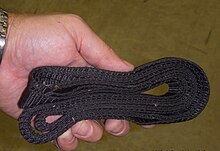Uses
While the terms may be used for a family of similar tools, they share a wide variety of established uses, including carrying un-charged fire hose, [2] opening doors, [6] closing doors, [7] securing hoselines, [8] dragging victims, [9] and even carrying boots. [3]
The use that gives the tool its name, however, is securing a charged hoseline, allowing a firefighter to better control and maneuver the line while flowing water. To use a hose strap in that manner, a firefighter secures the tool to the hoseline three to five feet behind the nozzle, using either the hook or a girth hitch, and loops the other end of the tool around his or her opposite side shoulder. [10]
Since the tool is attached several feet behind the firefighter, its use will not hinder a firefighter wearing a Self-contained breathing apparatus. For larger attack lines, such as a 2+1⁄2 inches (6.4 cm) hand line, second or third firefighters can use additional hose straps to secure the hose farther behind the nozzle operator, to provide additional leverage against the water pressure. Since multiple hose straps will typically be available to a team of firefighters, they can be used in combination to handle a variety of other tasks. For example, if a task requires greater length than that of a single hose strap, two hose straps may be connected via girth hitch.
This page is based on this
Wikipedia article Text is available under the
CC BY-SA 4.0 license; additional terms may apply.
Images, videos and audio are available under their respective licenses.

